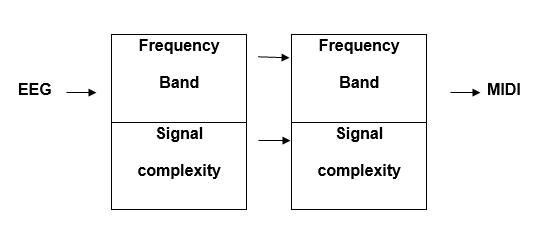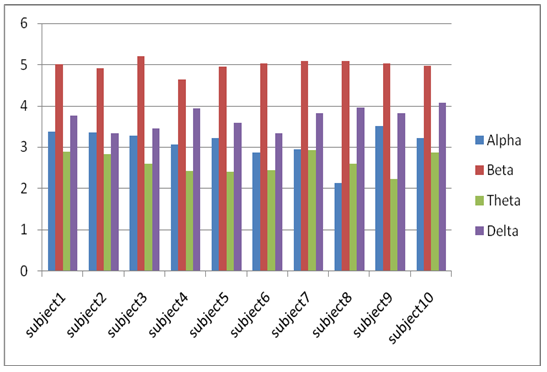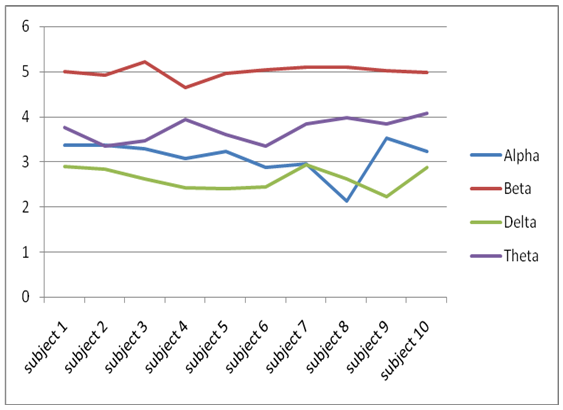Sound can be looked at as the habitual mechanical pulsation that moves or travels though a substance that has weight and occupies space. Sound usually has the common features of a waveform that is in the longitudinal mode. Sound waves having specific features can be seen as music. Changes of normal sound in tone, note, time durations, etc. create the melody/ music. Each brain state is represented by brain waves named Gamma, Beta, Alpha, Theta and Delta. There can be four main categories that the brainwave can be classified. The brain wave can either be in the alpha, theta, beta or theta groups. The various groups have varied frequency. EEG waves and sound waves share many characteristics.
Brain Music Therapy
Various processes are involved in transforming neural signals to sound signals or sonification of neural signals. The sonification of neural signals is accomplished in various steps with separate procedures. The stages include Data acquisition, Data pre-processing, intermediate representation (the creation of Visual and sonic map), and visualization and sonification. The chart below represents the process of sonification from neurofeedback.

Neurology studies show that temporary coordination between different and often distant neural assemblies plays a vital role in higher cognitive phenomena. Multiple cortical regions may become co-active during the cognitive task and also functionally interdependent. For instance, most information processing most likely takes place in the rear brain regions containing the visual cortex when eyes are open, whereas the principal processing occurs in the frontal brain when eyes are closed Bhattacharya et al.
It has been shown that listening to music helps to arrange the cortical patterns so that they may not wash out at the expense of other pattern development functions, and particularly, the right hemisphere processes, music is important for excitation and priming of the common repertoire and orderly flow of the cortical patterns responsible for higher brain functions, and helps in the enhancement and facilitation of the cortical symmetry operations among the inherent patterns. The cortex’s response to music can be thought of as the ‘Rosetta Stone’ for the ‘code’ or the internal language of higher brain function. Rauscher et al.
By analysing the components of an EEG namely alpha, beta, delta, and theta waves, a system can be developed to convert these waves into music by a process called sonification. Various studies show that this process can be applied in brain therapy. Neurofeedback has been applied to a range of clinical conditions such as epilepsy, attention deficit hyperactivity disorder, and the locked-in syndrome, and to optimize performance in healthy subjects. In healthy individuals, neurofeedback has been shown to improve artistry in music students and dance performance. Egner et al.
The Brain Music System is a system that transmits electroencephalographic data in converted MIDI. It is similar to the brain-computer interface (BCI) system created by Professor Eduardo Mirada but runs equally well on a duo channel EEG. The system uses the modified LORETA methodology which enables the system to obtain and predict information from 2/3 EEG channels. Data is modified before being saved in.edf format (European Standard EEG data file) thereby simplifying the process of being collected and computed on standard specialized software. The modification enables smaller devices to be less invasive using few electrodes and still be able to monitor clinical standard EEG data.
Objectives of the Study
- Check if there are common patterns and levels of Brainwave activity in EEG / QEEG outputs that can be optimally used in the musical process of the Brain Music System
- Outputs of the “modified LORETA” compared with published literature studies
Results
The results for ten subjects were collected and presented in the table below. The four different brain waves i.e., alpha, beta, delta, and theta were color-coded as green, red, yellow, and blue respectively. Table 1 represents the average values of the four forms of EEG waves for ten subjects.
Table 1. Average Band Frequency Values.


The linear band frequency graph 2 shows that throughout the analysis of brain waves, the Beta wave presented as the most significant form of the brain with the highest mean wave followed by Theta and Alfa waves respectively. The least form of brain wave was the delta wave which had consistently lower figures in most of the subjects.
Band Range Analysis
According to the linear graph, delta is statistically insignificant in this study in awake subjects and is thus deemed not relevant to include it. The means of the relevant bands recorded in the table above were analyzed and the resuwere lts presented in graphs 1 and 2. They indicate which of the bands had the most stable output, in order to further confirm which bands should be given priority for its role in the system. The results show that the Beta waves have the most stable output, followed by the Alpha and the Theta waves.
In this study, the Beta wave provides the best avenue for the study of the interaction between a musical peace and the brain. The results indicate that the left frontal regions of the brain are more involved in processing as shown by the higher mean of the beta range. The right hemisphere may also be increasingly engaged with higher frequencies of the beta wave. The beta range can be used to indicate the part of brain that is involved in processing a particular kind of music. The Theta band showed coherence in pattern in the ten subjects and that coherence increased symmetrically, except in just few cases. The Alpha band was characterized by more coherence decreases and extending over longer distances than other bands.
The interpretation of increases in coherence advances the theory of increasing cooperation between two regions of the brain. Decreases on the other hand indicate that mental process under investigation requires lower collaboration between the two regions in order to perform optimally.
Changes in gravity centres of coherence clearly indicate particular significance of the regions involved for processing information and how other cortical regions are involved. In the case of decreases, the region concerned may decouple from other cortical regions. Visual data processing studies have substantiated this view and can be applied to the alpha band as is the case in this study. In other words, attentive listening needs increased attention and suspends the freely floating thinking that could be assumed to take place upon EEG at rest; the two processes lead to “parcellation of the cortex in that frequency band that is concerned in general attentional processes.
Moreover, it could also be that cortical coherence is reduced for an increased information exchange with subcortical sites. The behaviour in the theta band was found to be fairly typical in processes where memory takes a significant part.” Hellmuth et al.
Conclusion
From this study, common patterns and levels of Brainwave activity in EEG / QEEG outputs can be optimally used in the musical process of the Brain Music System. The findings in the study are in keeping with other results found in literature whereby the beta waves present the highest frequency followed by theta and alpha waves respectively.
References
Abeles, M., Vaadia, E. and Bergman, H., Firing patterns in single units in the prefrontal cortex and neural network models. Network, 1 (1990) 13-25.
Alexandra T, Tiffany F, Maria H, Miguel D, and Nancy J. Music Effects on EEG in Intrusive and Withdrawn Mothers with Depressive Symptoms. Psychiatry 66(3) Fall (2003): 234-243.
Bhattacharyaa J, Hellmuth P, and Ernesto P. Interdependencies in the spontaneous EEG while listening to music. International Journal of Psychophysiology 42 (2001) 287_301.
Braitenberg, V. and Schiiz, A., Anatomy of the Cortex: Statistics and Geometry. Springer, Berlin (1991) 249 pp.
Bush, P.C. and Douglas, R.J., Synchronization of bursting action potential discharge in a model network of cortical neurons. Neur. Comp., 3 (1991) 19-30.
Eckhorn, R., Reitboeck, H.J., Arndt, M. and Dicke, P., A neural network for feature linking via synchronous activity: results from cat visual cortex and from simulations. In R.M.J. Cotterill (Ed.), Models of Brain Function, University Press, Cambridge (1989) pp. 155-272.
Edelman, G.M., The Remembered Present. A Biological Theory of Consciousness. Basic Books, New York, 1989, 346 pp.
Egner T, and Gruzelier J.H. The effects of neurofeedback training on the spectral topography of the electroencephalogram. Clinical Neurophysiology 115 (2004) 2452–2460.
Frances H, Rauscher A, Gordon L, Shaw A, and Katherine N. Listening to Mozart enhances spatial-temporal reasoning: towards a neurophysiological basis. Neuroscience Letters 185 (1995) 44-47.
Hellmuth P, Astrid S, Oliver FP. and Petsche, H., EEG aspects of mentally playing an instrument. Cognitive Brain Research 3 (1996) 115-123.
Janata, P. and Petsche, H., Spectral analysis of the EEG as a tool for evaluating expectancy violations of musical contexts. Music Percept., 10 (1993) 281-304.